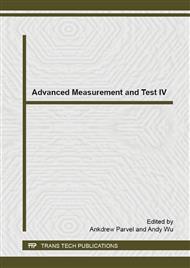[1]
R. Cajka, M. Krejsa, Measured data processing in civil structure using the DOProC method, Advanced Materials Research, Vol. 859 (2014) pp.114-121, ISSN: 1022-6680, ISBN: 978-303785979-7, DOI: 10. 4028/www. scientific. net/AMR. 859. 114.
DOI: 10.4028/www.scientific.net/amr.859.114
Google Scholar
[2]
CSN 73 0540-2, Thermal protection of buildings – Part 2: Requirements, Czech Standards Institute (2011). (in Czech).
Google Scholar
[3]
P. Janas, M. Krejsa, Statistical Dependence of Input Variables in DOProc Method, Transactions of the VSB – Technical University of Ostrava, Civil Engineering Series, Vol. 12, Issue 2 (2012).
DOI: 10.2478/v10160-012-0017-3
Google Scholar
[4]
P. Janas, M. Krejsa, V. Krejsa, Structural reliability assessment using a Direct Determined Probabilistic Calculation. In: Proceedings of the 12th International Conference on Civil, Structural and Environmental Engineering Computing (2009).
DOI: 10.4203/ccp.91.72
Google Scholar
[5]
J. Kralik, Deterministic and probabilistic analysis of steel frame bracing system efficiency, Applied Mechanics and Materials, Vol. 390 (2013) pp.172-177, ISSN: 1660-9336, ISBN: 978-303785833-2, DOI: 10. 4028/www. scientific. net/AMM. 390. 172.
DOI: 10.4028/www.scientific.net/amm.390.172
Google Scholar
[6]
M. Krejsa, P. Janas, V. Krejsa, Software Application of the DOProC Method, International Journal of Mathematics and Computers in Simulation, vol. 8. (2014) pp.121-126, ISSN: 1998-0159.
Google Scholar
[7]
M. Krejsa, P. Janas, V. Krejsa, ProbCalc - An efficient tool for probabilistic calculations, Advanced Materials Research, Vol. 969 (2014) pp.302-307, ISSN: 1662-8985, ISBN: 978-303835147-4, DOI: 10. 4028/www. scientific. net/AMR. 969. 302.
DOI: 10.4028/www.scientific.net/amr.969.302
Google Scholar
[8]
M. Krejsa, Probabilistic failure analysis of steel structures exposed to fatigue, Key Engineering Materials, Vol. 577-578 (2014), pp.101-104, DOI: 10. 4028/www. scientific. net/KEM. 577-578. 101.
DOI: 10.4028/www.scientific.net/kem.577-578.101
Google Scholar
[9]
M. Krejsa, Probabilistic reliability assessment of steel structures exposed to fatigue, In: Safety, Reliability and Risk Analysis: Beyond the Horizon - Proceedings of the European Safety and Reliability Conference, ESREL 2013 (2014).
DOI: 10.1201/b15938-404
Google Scholar
[10]
M. Krejsa, P. Janas, I. Yilmaz, M. Marschalko, T. Bouchal, The use of the Direct Optimized Probabilistic Calculation method in design of bolt reinforcement for underground and mining workings, The Scientific World Journal, Vol. 2013 (2013).
DOI: 10.1155/2013/267593
Google Scholar
[11]
V. Krivy, V. Urban, K. Vavrusova, An innovative prediction model for corrosion processes on weathering steel structures. In: Proceedings of 14th International Conference on Civil, Structural and Environmental Engineering Computing (2013).
DOI: 10.4203/ccp.108.48
Google Scholar
[12]
L. Kucerova, M. Cernikova, B. Hruba, Thermal technical assessment of selected constructions of wooden houses. Applied Mechanics and Materials, Vol. 470 (2013).
Google Scholar
[13]
H. Lahuta, I. Skotnicova, Dynamic thermal performance of building structures in experimental lightweight timber-frame passive house. In: Proceedings of 13th SGEM GeoConference on Nano, Bio And Green – Technologies For A Sustainable Future, Albena, Bulgaria (2013).
DOI: 10.5593/sgem2013/bf6/s26.008
Google Scholar
[14]
A. Lokaj, K. Klajmonova, V. Krivy, Reinforced round timber joints under static and cyclic loading, Advanced Materials Research, Vol. 893 (2014) pp.702-706, ISSN: 1022-6680, ISBN: 978-303835025-5, DOI: 10. 4028/www. scientific. net/AMR. 893. 702.
DOI: 10.4028/www.scientific.net/amr.893.702
Google Scholar
[15]
H. J. Moon, G. L. M. Augenbroe, Towards a practical mould growth risk indicator, Building Services Engineering Research and Technology, Vol. 25, Issue 4 (2004) pp.317-326, ISSN: 0143-6244, DOI: 10. 1191/0143624404bt101oa.
DOI: 10.1191/0143624404bt101oa
Google Scholar
[16]
D. Novak, M. Vorechovsky, B. Teply, FReET: Software for the statistical and reliability analysis of engineering problems and FReET-D: Degradation module, Advances in Engineering Software, Vol. 72 (2014).
DOI: 10.1016/j.advengsoft.2013.06.011
Google Scholar
[17]
M. Sykora, M. Holicky, J. Markova, Target reliability levels for assessment of existing structures, In: Proceedings of the 11th International Conference on Applications of Statistics and Probability in Civil Engineering (2011).
Google Scholar
[18]
J. Teslik, N. Zdrazilova, M. Vodickova, Airtightness and acoustic properties of family house from straw, Advanced Materials Research, Vol. 860-863 (2014).
DOI: 10.4028/www.scientific.net/amr.860-863.1215
Google Scholar
[19]
S. Thelandersson, T. Isaksson, Mould resistance design (MRD) model for evaluation of risk for microbial growth under varying climate conditions, Building and Environment, Vol. 65 (2013).
DOI: 10.1016/j.buildenv.2013.03.016
Google Scholar
[20]
I. Yilmaz, M. Marschalko et al., Monitoring of heat transmission from buildings into geological environment and evaluation of soil deformation consequences in foundation engineering. Environmental Earth Sciences (2014).
DOI: 10.1007/s12665-014-3200-2
Google Scholar


